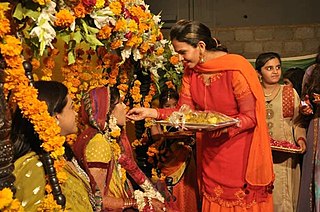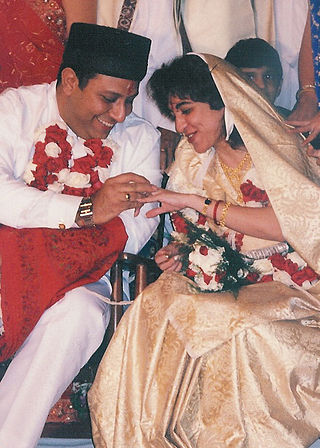
A wedding is a ceremony where two people are united in marriage. Wedding traditions and customs vary greatly between cultures, ethnic groups, races, religions, denominations, countries, social classes, and sexual orientations. Most wedding ceremonies involve an exchange of marriage vows by a couple, presentation of a gift, and a public proclamation of marriage by an authority figure or celebrant. Special wedding garments are often worn, and the ceremony is sometimes followed by a wedding reception. Music, poetry, prayers, or readings from religious texts or literature are also commonly incorporated into the ceremony, as well as superstitious customs.

An engagement or betrothal is the period of time between the declaration of acceptance of a marriage proposal and the marriage itself. During this period, a couple is said to be fiancés, betrothed,intended, affianced, engaged to be married, or simply engaged. Future brides and grooms may be called fiancée (feminine) or fiancé (masculine), the betrothed, a wife-to-be or husband-to-be, respectively. The duration of the courtship varies vastly, and is largely dependent on cultural norms or upon the agreement of the parties involved.

Baraat or Varayatra is a groom's wedding procession in Indian subcontinent. In Indian subcontinent, it is customary for the bridegroom to travel to the wedding venue on a mare, accompanied by his family members.

The Cirebon or Cirebonese are an indigenous ethnic group native to Cirebon in the northeastern region of West Java, Indonesia. With a population of approximately 1.9 million, Cirebonese population, they are mainly adherents of Sunni Islam. Their native language is the Cirebonese, which is a form of mixed language between the Javanese and Sundanese, with a heavier influence from Javanese.
A Hindu wedding, also known as Vivaha, Marathi: Lagna (लग्न), Bengali: Bibaho (বিবাহ), Kalyanam, Kannada script: ಮದುವೆ (Maduve), Tamil: திருமணம் (Tirumanam), or Pelli, is the traditional wedding ceremony for Hindus. The wedding ceremonies are very colourful, and celebrations may extend for several days and usually a large number of people attend the wedding functions. The bride's and groom's home—entrance, doors, wall, floor, roof—are sometimes decorated with colors, flowers, and other decorations.

The traditional Vietnamese wedding is one of the most important ceremonies in Vietnamese culture, which is influenced by Confucian and Buddhist ideologies.

A Bengali Muslim wedding is a Bengali wedding in accordance to Muslim faith.
Iranian wedding, also known as Persian wedding, consists of traditions rooted in Zoroastrianism, the primary religion of pre-Islamic Iran. Though the concepts and theories of marriage have been changed by Islamic traditions, the ceremonies have remained more or less the same as they were originally in pre-Islamic Iran. Although modern-day Iran is a multi-ethnic country, Iranian wedding traditions are embraced by the majority of ethnic groups in Iran.

Marriage in Pakistan pertains to wedding traditions established and adhered by Pakistani men and women. Despite their local and regional variations, marriages in Pakistan generally follow Islamic marital jurisprudence. Marriages are not only seen as a union between a husband and a wife, but also an alliance between their respective families. These traditions extend to other countries around in the world where Overseas Pakistani communities exist.

Punjabi wedding traditions are a strong reflection of Punjabi culture with ritual, song, dance, food, and dress that have evolved over centuries.

A Zoroastrian wedding is a religious ceremony in Zoroastrianism in which two individuals, a man and a woman, are united. In Zoroastrianism, marriage within the community is encouraged, and is greatly favored in religious texts. The following information will detail ceremony procedures and traditional processes for a Zoroastrian wedding.
Chinese pre-wedding customs are traditional Chinese rituals prescribed by the 禮記 (láih gei, the 儀禮 (yìh láih and the 白虎通 condensed into a series of rituals now known as the 三書六禮. Traditionally speaking, a wedding that incorporates all six rites is considered a daaih chéui.
Ukrainian wedding is the traditional marriage ceremony in Ukrainian culture, both in Ukraine and in the Ukrainian diaspora. The traditional Ukrainian wedding featured a rich assortment of folk music and singing, dancing, and visual art, with rituals dating back to the pre-Christian era. Over time, the ancient pagan traditions and symbols were integrated into Christian ones.

A vőfély is the Master of Ceremonies before, during and after a traditional wedding in Hungary. He wears a ribboned hat so he can be easily identified.
The Telugu Hindu wedding ceremony is the traditional wedding ceremony of the Telugu people in India. In the 19th century, the ceremony could last up to sixteen days. In modern times, it can last two or more days, depending on the family's financial and social status. The pelli or wedding is considered the strongest of social bonds, and is said to spiritually merge two souls opening the doors to gruhastaashramam. There is a Telugu saying that "Marriage is supposed to be a family union and not an individual formality." However, with changing mindset of the younger generation and due to globalization, marriage these days is being mainly focused solely on the union of the young couple only.
Bahaghara is a wedding ceremony performed by Odia Hindu people in the Indian state of Odisha. There are subtle differences in the rites observed by different castes. In Odia marriage rituals, the mother of the bridegroom does not take part in the ceremony. The Utkala Brahmins have their weddings only in the daytime, preferably at midday or in the morning, while the other caste weddings are done during the evening or night. There is the custom of sending betel nuts to family friends for inviting them to the marriage. The first invitation is sent to the family deity as a respect to the lord. Marriages in Odisha are mostly fixed and arranged by the parents. Marriages for serving or capturing is not common.

Bride price, bride-dowry, bride-wealth, bride service or bride token, is money, property, or other form of wealth paid by a groom or his family to the woman or the family of the woman he will be married to or is just about to marry. Bride dowry is equivalent to dowry paid to the groom in some cultures, or used by the bride to help establish the new household, and dower, which is property settled on the bride herself by the groom at the time of marriage. Some cultures may practice both simultaneously. Many cultures practiced bride dowry prior to existing records.

Traditional Hajong marriage is a ceremonial ritual that involves a marriage established by pre-arrangement between families. Within Hajong culture, romantic love and widow re-marriage was allowed, and monogamy was the norm for the Hajong people.
Weddings in Myanmar, considered auspicious occasions in Burmese culture, reflect various ethnic, religious, and regional traditions. Depending on an individual's family social economic status, personal preferences and titles held, Burmese weddings can be religious or secular, and extravagant or simple. Wedding expenses are covered by the groom's family. Myanmar is a predominantly Buddhist country, and many wedding customs and traditions are influenced by Buddhism.











